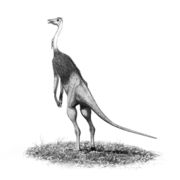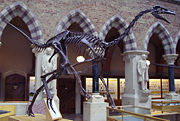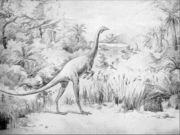Struthiomimus
2008/9 Schools Wikipedia Selection. Related subjects: Dinosaurs
| Struthiomimus Fossil range: Late Cretaceous |
||||||||||||||||
|---|---|---|---|---|---|---|---|---|---|---|---|---|---|---|---|---|
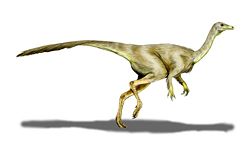 Illustration of a Struthiomimus specimen.
|
||||||||||||||||
| Scientific classification | ||||||||||||||||
|
||||||||||||||||
| Species | ||||||||||||||||
|
Struthiomimus (meaning "ostrich mimic", from the Greek στρουθιον/strouthion meaning 'ostrich' and μιμος/mimos meaning 'mimic' or 'imitator') is a genus of ornithomimid dinosaur from the late Cretaceous of Alberta, Canada. It was a long-legged, ostrich-like dinosaur.
The bipedal Struthiomimus stood about 4.3 meters long (14 ft) and 1.4 meters (4.6 ft) tall at the hips and weighed around 150 kilograms (330 lb). Struthiomimus is one of the more common small dinosaurs in the Dinosaur Provincial Park; its abundance suggests that it was a herbivore or omnivore rather than a carnivore.
Description
Struthiomimus had a typical build and skeletal structure for an ornithomimid, differing from genera like Ornithomimus and Dromiceiomimus in proportions and anatomical details. It is known from several skeletons and skulls, and its size is estimated as about 4.3 meters long (14 ft) and 1.4 meters (4.6 ft) tall at the hips, with a weight of around 150 kilograms (330 lb). As with other ornithomimids, it had a small slender head on a long neck (which made up about 40% of the length of the body in front of the hips). Its eyes were large and its jaws were toothless. Its vertebral column had ten neck vertebrae, sixteen back vertebrae, six hip vertebrae, and an unknown number of tail vertebrae. The tail was stiff and was probably used for balance.
Struthiomimus had long slender arms and hands, with immobile forearm bones but limited opposability between the first finger and the other two. It had the longest hands of any ornithomimid, with particularly long claws. The three fingers were roughly the same length, and the claws were only slightly curved; Henry Fairfield Osborn, describing a skeleton in 1917, compared the arm to that of a sloth. Its shin was longer than its thigh, a cursorial feature. Among ornithomimids, though, its legs were only moderately elongate. Its feet were elongate and the metatarsals were tightly appressed, with three toes tipped by claws with very slight curvature.
Struthiomimus, being a member of Coelurosauria, probably had feathers.
Discovery and species
In 1901 Lawrence Lambe found some incomplete remains and named them Ornithomimus altus, placing them in the same genus as material earlier described by Othniel Charles Marsh in 1890. The specific name altus is from Latin, meaning 'lofty' or 'noble'. However in 1914, a nearly complete skeleton was discovered by Barnum Brown, at the Red Deer River site in Alberta and officially described as the separate genus Struthiomimus by Henry Fairfield Osborn, in 1917.
Struthiomimus altus comes from the Late Campanian (Judithian age) Dinosaur Park Formation. Struthiomimus is also known from the Late Campanian/Early Maastrichtian (Edmontonian age) Horseshoe Canyon Formation. Because dinosaur faunas show rapid turnover, it is possible that these younger Struthiomimus specimens will prove to be a new species, but too little is known at this point to say whether these specimens do or do not belong to S. altus. Struthiomimus specimens from the Hell Creek Formation tend to have straighter and more elongate hand claws, similar to those seen in Ornithomimus. They most likely represent a new species of Struthiomimus, but these specimens have not yet been studied in depth.
Paleobiology
Diet
There has been much discussion about the feeding habits of Struthiomimus. Because of its straight-edged beak, Struthiomimus may have been an omnivore. Some theories suggest that it may have been a shore-dweller and may have been a filter feeder. Some paleontologists noted that it was more likely to be a carnivore because it is classified within the otherwise carnivorous theropod group. This theory has never been discounted, but Osborn, who described and named the dinosaur, proposed that it probably ate buds and shoots from trees, shrubs and other plants, using its forelimbs to grasp branches and its long neck to enable it accurately to select particular items. This herbivorous diet is further supported by the unusual structure of its hands. The second and third fingers were of equal length, could not function independently, and were probably bound together by skin as a single unit. This indicates that the hand was used as a "hook", for bringing branches or fern fronds within reach.
Speed
The legs (hind limbs) of Struthiomimus were long, powerful and seemingly well-suited to rapid running, much like an ostrich. The supposed speed of Struthiomimus was, in fact, its main defense from predators (although it may also have been able to lash out with its hind claws when cornered), such as the dromaeosaurids (e.g. Saurornitholestes and Dromaeosaurus) and tyrannosaurs (e.g. Daspletosaurus and Gorgosaurus) which lived at the same time. It is estimated to have been able to run at speeds between 50 to 80 km/h (30 to 50 mph).
Posture
Early restorations depict a posture reminiscent of the 'walking tripod' postures of Tyrannosaurus and Iguanodon, before the later more balanced depictions with stiffened horizontal tails and bodies were widely accepted. This newer view creates an image much more reminiscent of modern flightless birds, such as the ostrich to which this dinosaur's name refers.
Popular culture
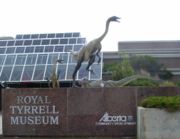
The best-preserved skeleton of Struthiomimus is currently on display at the American Museum of Natural History, in Manhattan, New York, while the best-preserved skull is currently on display at the Royal Tyrrell Museum of Palaeontology, in Drumheller, Alberta, Canada.
Struthiomimus has appeared in several dinosaur-related films and television programs, such as the egg-napping villains in The Land Before Time II: The Great Valley Adventure. They played a prominent role in the Disney animated film Dinosaur, and in 1985, Struthiomimus was featured in "Dinosaur!", a CBS television documentary hosted by the late Christopher Reeve. In a stop-motion animation sequence, a Struthiomimus was shown feeding on hadrosaurid eggs and escaping the angry mother, only to be preyed upon by a pair of Deinonychus a few moments later (though in reality Deinonychus lived in the early Cretaceous Period and was not a contemporary of Struthiomimus). Struthiomimus toys were included in the Dino-Riders line by Tyco, and was later re-released in the Smithsonian toy line.
